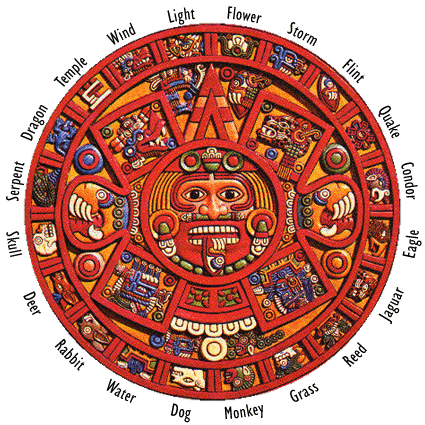
by John P. Pratt (10 May 2011)
©2011 by John P. Pratt. All rights Reserved.
| 1. The Sacred Round |
| 1.1 The 20-day Veintena |
| 1.2 The 13-day Trecena |
| 1.3 How are the Trecenas Arranged? |
| 1.4 Where is the Zero on a Clock? |
| 2. Book of Mormon |
| 2.1 First Light |
| 2.2 Quickening |
| 2.3 Birth |
| 2.4 Evil |
| 2.5 Life |
| 2.6 Death |
| 2.7 Spirit |
| 2.8 Chance? |
| 3. Conclusion |
| Notes |
The Book of Mormon, a foundational scripture for the "Mormon" Church, was translated from Native American writings on golden plates. There are seven events in the history of the book's coming forth that can be compared to the "life" of those plates. These correspond to seven figures used in the Sacred Round of the Native American calendar which symbolize those milestones of life. Each figure names a 13-day period, called a trecena, which only occurs about once every 9 months. This article announces two discoveries. First, it points out that all seven of those events occurred during the trecena with the corresponding name. Moreover, all seven occurred in the same order as in life. The timing of those events was mostly under the direction of one of the book's authors, Moroni, who appeared to the translator Joseph Smith as an angel and directed the entire process. The likelihood of all seven of those events happening in order at those times just by chance is so small that it indicates that those events were purposely timed using the Sacred Round. That in turn is a witness that the Book of Mormon is indeed an authentic Native American work. The second discovery is a technical detail of how the trecenas are named. It is usually assumed they are named for the first of the 13 days, as was done by the Aztecs, but this discovery shows that they should be named for the last day, a custom used by the Mayans.
This is a somewhat technical paper intended mostly for serious students of the Sacred Round, and especially for Native Americans who still actually use it. It is more about exactly how to use the Sacred Round in practice than it is about religion. Because the Sacred Round might well have use in the everyday life of the next generation, a set of more modern pictures for its use is also presented. Let us then begin with a review of the Sacred Round.
The 260-day Sacred Round (also called the tzolkin) is the heart of the Aztec Calendar, the Mayan calendar and nearly every native calendar of the Americas. It is composed of two cycles, one of 20 named days, and one of 13 numbered days, each of which continuously repeats. It takes 260 days for the two cycles to realign on the beginning day of each cycle (260 = 20 x13), so the Sacred Round has 260 days.
The details are described below, but it should be noted at the outset that to this author, the Sacred Round is important enough that it could be used by even modern people, rather than being only be a curious artifact of an ancient culture.
 |
| 1. Light | |
|---|---|
| 2. Wind | |
| 3. Temple | |
| 4. Dragon | |
| 5. Serpent | |
| 6. Skull | |
| 7. Deer | |
| 8. Rabbit | |
| 9. Water | |
| 10. Dog | |
| 11. Monkey | |
| 12. Grass | |
| 13. Reed | |
| 14. Jaguar | |
| 15. Eagle | |
| 16. Condor | |
| 17. Quake | |
| 18. Flint | |
| 19. Storm | |
| 20. Flower | |
Each of the twenty days is named and has an associated picture or glyph. The 20 day glyphs are shown in a circle in the famous Aztec Calendar Stone. This illustration is only of the central part of that calendar. The 20-day cycle begins at the top and goes around counter-clockwise.
The names were chosen by this author as the best English words to describe the idea. Most tribes had slight variations of the pictures and of what the name should be. For example, the first figure was either a crocodile, a water lily, or the sun. In every case, according to the Mayan priests, the original idea was that of the conception of new life. The crocodile and water lily, both floating in the water, fit the image of a fetus in the womb. The Olmec figure of the sun may represent the moment when the spark of life begins. I chose the word "Light" to best summarize this idea, and have proposed the figure of a sunrise to symbolize the first flash of dawn as representing that spark. A comparison of the Mixtec glyphs (from the Codex Nuttall) and my proposed modern icons are shown at left. The Mixtec figures are only slightly different from the Aztec.
The days were said by the Mayans to represent the steps in a person's life (from before birth to after resurrection). Thus, after the first day (Light) which represents conception, the second (Wind) is quickening, when the spirit enters the baby still in the womb, and the third (Temple) is the day of birth. The fourth (Dragon) is the day when evil is first allowed into the child's life, and the fifth (Serpent) seems to represent the entire experience of mortality. The sixth (Skull) represents death, and the seventh (Deer) represents the fleeting journey into the spirit world. The final thirteen steps are less clear, as is our understanding of life after death. The names and symbolism are explained in more detail on a separate page.
Note that the circular arrangement is important because there are several pairs of opposites. For example, the fifth day in the cycle is "Serpent," and directly opposite the serpent is the "Eagle." The eagle/serpent pair was so important to the Aztecs that their capital (now Mexico City) was founded where they saw the eagle with the serpent in its talons (now immortalized on the Mexican flag.)
The veintena is also the fundamental cycle of the Mayan Long Count, which is not discussed here. Moreover, Native American astrology, which assigns similar traits to people, is based on the day of the veintena on which they are born. This is described in a book entitled The Cherokee Sacred Calendar, by Raven Hail.
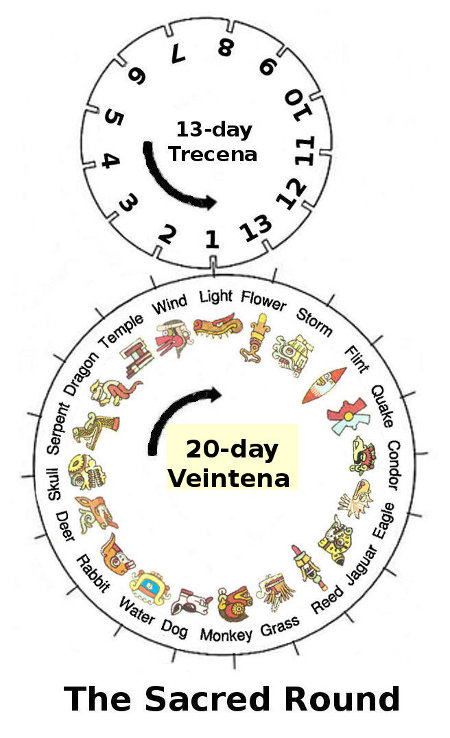 |
The two cycles each separately move through one day at a time, so the effect is similar to two gears, one with 13 cogs and the other with 20, as shown in the illustration. Thus, the Sacred Round begins at the position shown on the day 1 Light. The next day is 2 Wind and then 3 Temple. That may sound confusing if were expecting 1 Light to be followed by 2 Light and then 3 Light. But we do the same thing on our modern Gregorian calendar. The day after Monday the 1st (of a month) is Tuesday the 2nd. That is because the week of seven days progresses daily even as do the days of the month. The thirteenth day of the cycle is 13 Reed. The following day is 1 Jaguar, because the trecena starts over, but the veintena continues on through all 20 figures. It takes 260 days to get back to the starting position (13 x 20 = 260), so the Sacred Round contains 260 days.
Almost every author I have read gets this backwards. The only reason modern authors usually list the Sacred Round as 13 groups of 20 is that it is much easier to make a table of 260 numbers rather than 260 words or glyphs. But it is important to get it right if one actually wants to use it. Because the arrangement of the trecenas is the central point of this article, let us examine it further.
The Codex Borbonicus, a Native American work, contains detailed illustrations of each of the trecenas. For example, the thirteenth page lists all of the days in the thirteenth trecena. If you look at the table of the entire Sacred Round referenced in the first paragraph of this section, it will be seen that the thirteenth trecena is named "1 Quake", after its first day. That trecena is illustrated in detail on that page as shown in this illustration.
Let us look at this carefully to show how the trecena was understood by the Aztecs. I've taken the bottom border of this codex page and part of the vertical part and combined them into the following illustration so the thirteen days of the trecena can be seen clearly. Clicking on the illustration will show the entire page.
Look at the first square in the upper left in the illustration. On the left you see one dot above the glyph for Quake. That is how the day 1 Quake is represented. In the next picture there are two dots and the glyph for Flint, representing 2 Flint. Each day follows in succession by counting the circles with the glyph, until the last day, which is 13 Water. This clearly shows how the trecena was reckoned by the author of the codex.
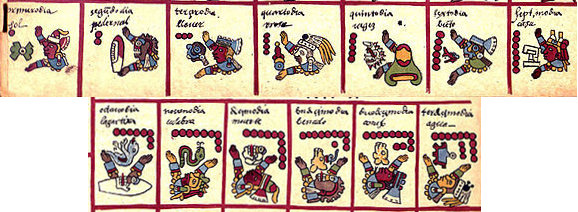 |
The discovery announced in this paper is based on a different way of looking at the trecena. Since my purpose has always been to discover if God is the Creator of these calendars, and if so, to understand how He uses them, then the possibility exists that the true method of their use had been lost by the Native Americans over the centuries. So let us now consider why one might name a trecena for the last day rather than the first day.
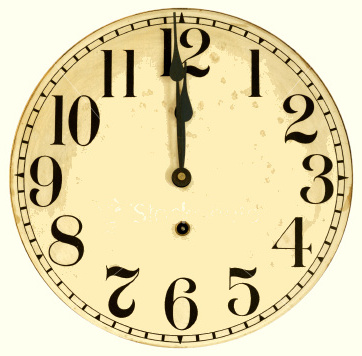 |
Okay, time's up (pun intended). As shown in the illustration as a hint, the effective "zero" on a clock is the 12. That is when the day begins. In fact, on a 24-hour clock, 12:00 midnight is called 0:00 hours. The hour beginning at midnight is the first hour. When the small hand reaches the "1", the first hour is ended. Thus, we name the hours by the marker at the end, rather than at the beginning. But until it is 1:00, we count the minutes as part of the "12" hour. Thus, 12:30 a.m. is half way through the first hour.
Similarly, the days of a trecena are numbered from 1 to 13, like the hours are numbered from 1 to 12. In the same manner as our clockface, the "13" can serve as the "0", exactly as if the days had been numbered from 0 to 12, and the trecena named for the "0" day, which is called "13". This is tricky but very important. By the same reasoning, the last picture of the twenty of the veintena can be thought of as the "zeroth" picture rather than the twentieth. In the Mayan Long Count, that is exactly how the 20 days are reckoned, from 0-19 rather than 1-20. So these ideas would have been very familiar to the Native Americans, who often used the last number to represent zero. We do the same on a clock without thinking about it.
With that in mind, I have rearranged the Sacred Round with another possible interpretation, different from the Mixtec that we saw above. It starts on 13 Flower, which is like Day 0 and Picture 0 (rather than day 13 and Picture 20). It still has thirteen days in each trecena, but now the last day of the first trecena is 12 Grass rather than 13 Reed. We can call the name of the trecena simply "Flower" because it always starts on the zeroth day 13 Flower. Similarly the second trecena is now Reed, rather than Jaguar. This arrangement of the Sacred Round is shown using modern icons.
The first seven days of the veintena represent part of the life cycle of mankind and of all living creatures. As stated above, those seven days represent conception (Light), quickening (Wind), birth (Temple), evil appearing (Dragon), life (Serpent), death (Skull) and entering the Spirit World (Deer).
Using the new notation, there are now trecenas with those names. That is, there is a 13-day period known as "Light". What is proposed in this article is that the first "spark of light" involved in the coming forth of the Book of Mormon occurred during a trecena called "Light". Then, the time when Spirit was breathed into the project occurred during a trecena named "Wind", and so on.
A very important point here is that the trecenas are not in the same order as the days of the veintena. That is the trecena which follows "Light" is not "Wind" but rather "Jaguar". The Wind trecena begins 221 days after the Light trecena. So if we want to see the trecenas in the same order as the 20 day glyphs, we have to wait 221 days, or nearly 8 months. That is what my claim is for the coming forth of the Book of Mormon. That is, the seven steps of life are in order, and they occurrd in 13-day trecenas that where spaced at least 221 days apart. In some case, one must wait a multiple of 260 days for the trecena to come around again. It is because it is so unlikely to have all seven dates of key events in the life cycle of the golden plates to fit such an unusual pattern, it was concluded by this author that a) this is right way to count the trecena and b) the restoration of the Book of Mormon was actually planned out using the Native American calendar in this manner.
Now let us look at seven events in the coming forth of the Book of Mormon which seem to fit his pattern very well. A better way to phrase it, is to look at seven events in the "life cycle" of the golden plates, from which the Book of Mormon was translated. Before reading ahead, ask yourself, what event would represent their "birth"? What would be their "death"? We are not used to thinking in these terms, but it is instructive to do.
 |
The answer proposed here is that the first light that came forth to herald the coming of the Book of Mormon occurred at the First Vision. It has been proposed in an earlier paper that the date of the First Vision was Sun 26 Mar 1820. Using the new notation, that day would be in a trecena called "Light". This can be seen by entering the day on my Calendar Spreadsheet and seeing that it was 3 Dragon (3 Lizard). Looking at the new table arrangement, one can see that 3 Dragon occurs in the "Light" trecena. So the proposed First Vision date occurs in the trecena Light, representing the dawning, or first light of something coming forth. When I began this research, I thought that it would represent the coming forth of the Mormon Church, but the pattern fits the Book of Mormon instead.
 |
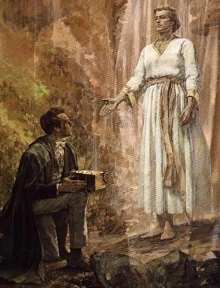 |
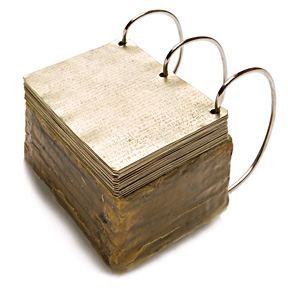 |
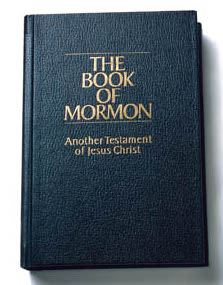 |
| Trecena | Meaning | Start Date | Event During Trecena |
|---|---|---|---|
| Light | First Spark | 23 Mar 1820 | First Vision |
| Wind | Quickening | 5 Sep 1823 | Spirit to Pray |
| Temple | Birth | 15 Sep 1825 | Plates Emerge From Earth |
| Dragon | Evil | 26 Sep 1827 | Attempts to Steal Plates |
| Serpent | Life | 4 May 1828 | 116 Pages translated |
| Skull | Death | 28 Aug 1829 | Plates Buried in Earth |
| Deer | Spirit | 6 April 1830 | Church founded |
What are the chances that all seven of these events happened in order by chance? It is difficult to calculate exactly because 1) the author was allowed to pick and choose events that seemed to fit (a real no-no to statisticians!), and 2) some of the events are not even known to have occurred with certainty, such as the re-burial of the plates. But even allowing for that, one notes that the shortest period in which all seven trecenas occur in order is 6 x 221 = 1326 days, or 3.6 years. So once the First Vision is chosen to begin the milestone list, and the founding of the Church (a direct hit to the very day) is taken as the endpoint, then there is only a ten year period into which to fit the other five points. There are only 9 extra cycles of 260 days in that interval that can be skipped to look for another bull's-eye. To have five events happen in that period that intuitively fit so well in mere 13-day intervals, which only 9 adjustments possible, to me is far beyond reasonable chance.